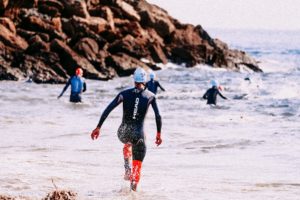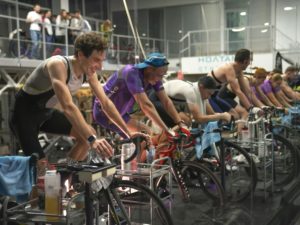Since Kristian Blummenfelt and Gustav Iden dominate the triathlon world, everyone is talking about “Norwegian training model”The system is considered scientific, controlled, and uncompromising. But what's really behind it – and how much of it is genuine? working age groupers even practical?
🇳🇴 What is the Norwegian training method?
The Norwegian method is not a single training plan, but a Philosophy and process modelDeveloped by trainers such as Olav Aleksander Bu and Marius BakkenIt combines physiology, data analysis, and precision. The goal: maximum performance development under controlled stress.
Key features
- High training volume at low intensity: 80–90 % of the training takes place below the anaerobic threshold.
- Double Threshold Units: Two sessions per day in the lactate range ~2.5–3.0 mmol/l, precisely controlled.
- Lactate-controlled intensity (LGTIT): Speed and performance are adapted to metabolism, not pace or power.
- Close diagnostics: Regular measurements of lactate, VO₂max, HRV, temperature and blood values.
- Targeted nutritional control: High carbohydrate intake on key days, controlled energy manipulation.
- Process rather than result orientation: The focus is on long-term adaptation, not on short-term peak performance.
 How do working age groupers typically train?
How do working age groupers typically train?
Most “standard triathlon plans” on the internet (8–12 hours/week) are based on Time economy optimized:
- 1-2 intensive training sessions per week (interval or threshold)
- 1 long run or bike ride
- 2–3 basic units + 1 rest day
- Controlled via heart rate or power output, no lactate measurement
- Often polarized or pyramidal, but simplified
Conclusion: Efficiency takes precedence over perfection – and that's exactly right for everyday life.
Comparison: Norwegian model vs. standard age group training
| feature | Norwegian method | Age grouper training |
|---|---|---|
| Training scope | 25–35 hours/week | 8–12 hours/week |
| Intensity control | Lactate, diagnostics, HRV | Heart rate, power, feeling |
| structure | Scientifically planned, closely monitored | Practical, suitable for everyday use |
| Goal | Maximum physiological adaptation | Increased performance with life balance |
| Repetition principle | Double-threshold days, constant stimuli | Varying weekly structure |
What can age groupers learn from the Norwegian method?
✅ 1. Consciously control intensity
Train in a controlled manner below your thresholdInstead of running every interval "all out." Use heart rate or power with clear zones.
✅ 2. Pyramidal structure
Structure your training like this:
- 70–80 % light
- 15–20 % moderate (aerobic threshold, not anaerobic!)
- 5–10 % hard
✅ 3. Process discipline
Test regularly (e.g., FTP or 5km test), implement a Training diary and monitor progress – that is “Norwegian Thinking”.
✅ 4. Periodize your diet
High-carb for tough days, enough calories for recovery – no persistent energy deficit.
✅ 5. Occasional “double-light” days
A moderate double session per week can be useful: 3×10′ cycling just below threshold in the morning, 5×3′ brisk run in the evening.
What is not practical or advisable
- Extreme workload (30 hours/week) – exceeds the recovery budget of a working person.
- Lactate measurement at every session – too expensive, too complex.
- Unsupervised heat training – potentially dangerous.
- Professional double blocks on a regular basis – risk of overtraining.
- Specializing too early – better to build up over the long term.
 Conclusion: The best of both worlds
Conclusion: The best of both worlds
The Norwegian model is not magic, but Science + Consequence: lots of clean basic training, finely controlled threshold stimuli and process discipline.
What you can do as an age grouper:
- Control intensity cleanly
- Pyramidal planning
- Use feedback & measurement points
- Live process discipline
What you should avoid:
- Copy professional scope
- Double-threshold duration blocks
- Lactate as dogma
The Norwegian method shows: Science beats chance – but only if it fits into your everyday life.
Conclusion in one sentence
The Norwegian method shows what is possible when you make training a science – but for age groupers, what counts is intelligently simplifying this science.


